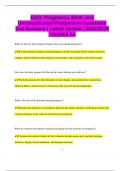EAQ- Pregnancy, Birth, and
Uncomplicated Postpartum Questions
and Answers | Latest Update | 2024/2025
| Graded A+
What are the key physiological changes that occur during pregnancy?
✔✔Key physiological changes during pregnancy include increased blood volume, hormonal
changes, altered cardiovascular function, and changes in the respiratory and renal systems.
How does the body prepare for labor in the weeks leading up to delivery?
✔✔The body prepares for labor through cervical changes, increased uterine contractions
(Braxton Hicks), and the release of hormones like oxytocin and prostaglandins.
What is the role of the placenta during pregnancy?
✔✔The placenta functions as an interface between the mother and fetus, facilitating nutrient and
oxygen exchange, waste removal, and hormone production.
What are common discomforts experienced during the first trimester of pregnancy?
✔✔Common discomforts during the first trimester include nausea and vomiting (morning
sickness), fatigue, breast tenderness, and frequent urination.
1
,How can a healthcare provider support a pregnant person experiencing anxiety about childbirth?
✔✔A healthcare provider can support by offering reassurance, providing education about the
labor process, and discussing coping strategies and relaxation techniques.
What are the signs of preterm labor that a pregnant person should be aware of?
✔✔Signs of preterm labor include regular contractions, lower back pain, pelvic pressure, and
changes in vaginal discharge before 37 weeks of pregnancy.
What is the importance of prenatal care during pregnancy?
✔✔Prenatal care is important for monitoring the health of both the mother and fetus, managing
any complications, and providing education and resources for a healthy pregnancy.
What lifestyle modifications can help manage gestational diabetes?
✔✔Lifestyle modifications for managing gestational diabetes include dietary changes, regular
physical activity, blood glucose monitoring, and sometimes insulin therapy if needed.
How does a doula support a birthing person during labor?
2
,✔✔A doula supports a birthing person by providing continuous emotional support, comfort
measures, and advocacy for the birthing person’s preferences and needs.
What are the key components of an uncomplicated vaginal birth?
✔✔Key components of an uncomplicated vaginal birth include a spontaneous onset of labor, a
healthy fetal heart rate, and the absence of complications during labor and delivery.
What are the common signs of a successful breastfeeding initiation?
✔✔Signs of successful breastfeeding initiation include the baby latching effectively, swallowing
sounds during feeding, and the mother feeling comfortable and relaxed.
What postpartum care should be provided to a person who has just given birth?
✔✔Postpartum care includes monitoring vital signs, assessing for bleeding, providing education
on self-care and infant care, and offering support for emotional well-being.
What are the recommendations for postpartum exercise?
✔✔Postpartum exercise recommendations include starting with gentle activities like walking and
gradually increasing intensity as the mother feels ready, typically after receiving clearance from
a healthcare provider.
3
, How can a healthcare provider help manage postpartum depression?
✔✔A healthcare provider can help manage postpartum depression by providing screenings,
offering counseling or therapy referrals, and discussing medication options if necessary.
What are the signs of potential complications during the postpartum period?
✔✔Signs of potential complications include excessive bleeding, severe pain, signs of infection
(fever, chills, foul-smelling discharge), and emotional distress.
How does skin-to-skin contact benefit both the newborn and the mother?
✔✔Skin-to-skin contact benefits the newborn by promoting bonding, regulating body
temperature, and encouraging breastfeeding; it helps the mother by enhancing emotional
connection and reducing stress.
What is the significance of the Apgar score at one and five minutes after birth?
✔✔The Apgar score assesses the newborn's physical condition and helps determine if immediate
medical intervention is needed. It evaluates heart rate, respiratory effort, muscle tone, reflex
response, and skin color.
4





